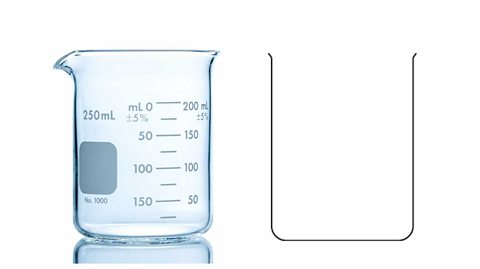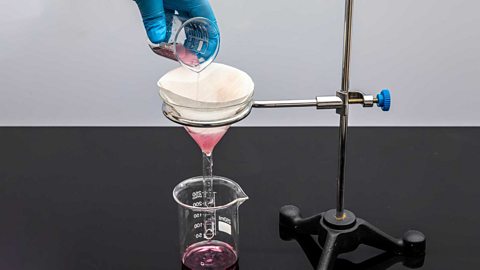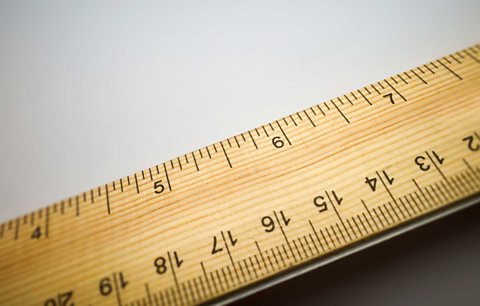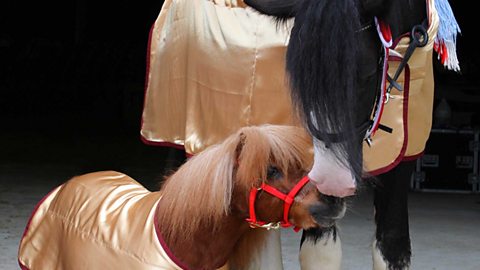Key points
- Use diagrams to show how scientific apparatus is set up.
- Scientists must be able to read measuring instruments properly.
- Common practical techniques that use apparatus include filtration, evaporation and distillation,
What piece of stationery should be used to draw diagrams in science?
A pencil.
Diagrams of equipment
Equipment used in science is often called apparatusPieces of equipment. . Diagrams of apparatus being used are usually drawn instead of pictures.
Diagrams should be:
- Drawn in pencil. Lines should be firm and continuous with no gaps or shading - not sketchy like in art.
- As large as necessary to show clearly what is being represented.
- Labelled using separate ruled lines. One end of the line should be clearly pointing at the apparatus, and at the other end, the label is written. These labels should be spread out and the lines should not overlap each other.
An example of a diagram of scientific apparatus
In science, what is drawn instead of a picture to show an experimental set-up?
A diagram.
Drawing apparatus
Diagrams make it clear how pieces of apparatus are linked together.

cross-section diagramsA two-dimensional drawing of what something would look like if it was cut in half and viewed from the side. show what a piece of equipment would look like if it was cut in half and viewed from the side. In this image, a glass beaker is shown alongside a cross-section 2D diagram. It is much easier to draw than drawing a picture of the beaker.

Cross-section diagrams are used in science to help make scientific diagrams of apparatus clear and easy to understand what they show. Individual diagrams of equipment can be combined to show a practical technique.
Why are scientific diagrams drawn instead of pictures?
They are easier to draw and clearly show how equipment links together.
In science 3D pictures are simplified to 2D cross-section diagrams.
Below are the most common pieces of apparatus found in a science lab:
Which piece of equipment is represented by an arrow pointing upwards with the word āheatā written underneath it?
A Bunsen burner.
Common practical techniques

Image caption, Filtration
Experiments carried out in a lab can be represented by drawing labelled diagrams. The photograph shows a practical technique known as filtration. It's used to separate a solid that doesn't dissolve in a liquid.
Image caption, Filtration - 2D cross-section diagram
Using 2D cross-section diagrams, filtration can be drawn more easily than trying to draw the actual equipment.
Image caption, Evaporation
Using a Bunsen burner to evaporate - to turn a liquid into a gas - some water during an experiment is another practical technique that is often used.
Image caption, Evaporation - 2D cross-section diagram
In the cross-section diagram for this practical technique of evaporating water, an arrow is used to show heat. This can be used in place of the image of the Bunsen burner to save time.
Image caption, Distillation
There are other more complicated practical techniques in science that use a lot of equipment. This technique is called distillation. Distillation is used to separate substances by turning a liquid into a gas, then back into a liquid.
Image caption, Distillation - 2D cross-section diagram
When drawing this cross-section diagram, itās important to take great care so that no tubes are blocked off that should be open.
1 of 6
What can you use on a diagram to show that something is being heated, instead of showing a Bunsen burner?
Use an arrow on a diagram to show that something is being heated.
Reading a scale
When doing an experiment in science, something usually has to be measured. These measurements are taken using different pieces of equipment such as:

- A ruler - to measure a length or distance.
- A measuring cylinder ā to measure volumes of liquids.
- A force meter ā to measure the size of a force.

Reading the numbers accurateA measurement that is close to the true value. from a scale first, then recording them is very important.
Look at the divisionsThe smallest markings on a scale that readings can be taken from. on the scale to work out what they mean before taking a measurement.
Some instruments like rulers have two scales on. It is important to use the correct scale. In science, centimetres or millimetres are used to measure distance on rulers, and not inches.
What is a ruler used to measure?
Length or distance.
What are the markings on a scale called?
Divisions.
Test your knowledge
Quiz - Select the correct scientific apparatus
Quiz - Drawing scientific apparatus
Did you know?

Throughout history body parts have been used to measure things.A āhandā is an example of this and is actually still used today to measure horse height - although now it has been defined as a measurement of four inches.A āhandā as a unit can be traced back to the ancient Egyptians.

Play the Atomic Labs game! gamePlay the Atomic Labs game!
Try out practical experiments in this KS3 science game.

More on Practical tips
Find out more by working through a topic
- count7 of 11

- count8 of 11

- count9 of 11

- count10 of 11
